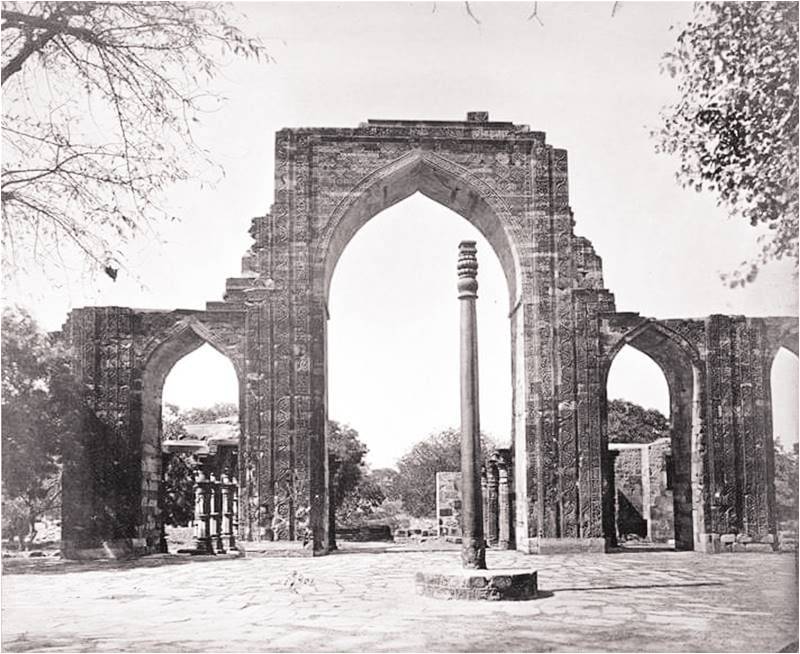
This photograph was captured by Thomas A. Rust in 1870s and shows some parts of the Quwwat-ul-Islam mosque. Its construction was launched in 1192 by Qutub-ud-din Aibak, who wanted to mark his victory over Rajput Jains. It was completed by his successor Iltutmish in 1215. This was the first mosque built in Delhi after the Islamic conquest of India, and is the oldest surviving example of Ghurid architecture in the Indian subcontinent. The Qutb Minar, which is about 72.5 metres in height, was built as a victory tower attached to the mosque.
The complex also contains the Iron Pillar of Delhi, which was constructed by a “King Chandra” (probably Chandragupta II). It is famous for rust-resistant composition of metals used in its construction. The pillar has attracted the attention of archaeologists and materials scientists because of its high resistance to corrosion and has been called a “testimony to the high level of skill achieved by the ancient Indian iron smiths in the extraction and processing of iron.” The pillar weighs over 5,865 kilogrammes and is thought to have been erected in what is now Udayagiri and reused by one of the Gupta monarchs in approximately 402CE, though the precise date and location are a matter of dispute.
The Iron Pillar is located on the stone pavement in front of mosque, while the Qutb Minar is located west of the main entrance. The central arch of the mosque is ogee in shape and is 6.5 metres wide and 16 metres tall. The side arches are smaller in size. The screen is sculpted with religious texts and floral patterns.
According to a Persian inscription which can still be seen on the inner eastern gateway, the mosque also contains parts of 27 Jain temples which were built previously during the reigns of the Tomaras and Prithviraj Chauhan.
The complex also contains the Iron Pillar of Delhi, which was constructed by a “King Chandra” (probably Chandragupta II). It is famous for rust-resistant composition of metals used in its construction. The pillar has attracted the attention of archaeologists and materials scientists because of its high resistance to corrosion and has been called a “testimony to the high level of skill achieved by the ancient Indian iron smiths in the extraction and processing of iron.” The pillar weighs over 5,865 kilogrammes and is thought to have been erected in what is now Udayagiri and reused by one of the Gupta monarchs in approximately 402CE, though the precise date and location are a matter of dispute.
The Iron Pillar is located on the stone pavement in front of mosque, while the Qutb Minar is located west of the main entrance. The central arch of the mosque is ogee in shape and is 6.5 metres wide and 16 metres tall. The side arches are smaller in size. The screen is sculpted with religious texts and floral patterns.
According to a Persian inscription which can still be seen on the inner eastern gateway, the mosque also contains parts of 27 Jain temples which were built previously during the reigns of the Tomaras and Prithviraj Chauhan.

